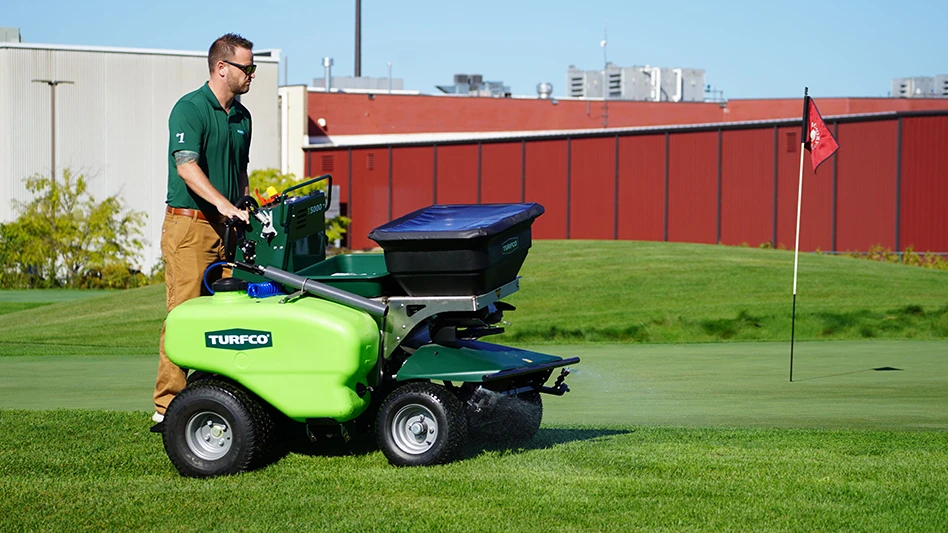For a long time, everyone thought lowering the height of cut on greens was the only way to achieve faster speeds. Turns out everyone was wrong.
Research shows a combination of mowing and rolling greens is the way to go. Rolling greens is an age-old practice that fell out of vogue between the late 1920s and the 1980s. Twenty years after the discussion of rolling reemerged, when research showed its merits, rolling greens has caught on again. Since the beginning of this decade, superintendents throughout the country have rediscovered how rolling, in addition to mowing, can save time and money; produce smoother, faster greens and even stop the spread of disease.
“I know more and more people who are doing it,” says Thom Nikolai, Ph.D., turfgrass academic specialist at Michigan State University. “I don’t know anyone who doesn’t roll.”
Nikolai wrote a book about greens rolling, “The Superintendent’s Guide to Controlling Putting Green Speed,” which was published by Wiley & Sons in 2006. Nikolai says if he writes another edition, he’ll write more like 80 pages rather than the 20 he did in his latest book.
Nikolai also lectures about greens rolling.
“I believe it was 2002 in Orlando where I gave a talk,” he says. “I was given 25 minutes. I asked how many people roll regularly. Two hands went up of the couple hundred people who were there. I gave my talk, and someone came up and said, ‘You just sold a roller to every single guy in that room.’ I was trying to get a couple of roller companies to fund a study with me prior to that presentation, and they wouldn’t. After my presentation, they all decided to fund research that year. It worked out well.”
Nikolai has access to a repository of almost every paper ever written about golf course management practices called the Turfgrass Information File. The mechanical mower was invented in 1836, and before that, courses were “mowed” by bunnies and sheep, he says.
“I strongly believe rolling was the first mechanical practice, but I have been unable to find a reference to green rolling prior to 1900,” he says.
Nikolai believes rolling lost favor for two reasons. First, in the mid- to late 1920s, there was an outburst of new mower invention, and suddenly, grass could be mowed to .187 inch. With those heights, greens were fast enough. The second reason was that people thought compaction as a result of rolling wasn’t good for root growth.
“So rolling disappeared from the literature,” Nikolai says. “From 1900 to 1928, we’ll say you could find numerous articles about lightweight rolling on greens. You get to the point where there’s a debate about it, how often and how much they should weigh. From the late 1920s to the late 1980s, every hit you get is for rolling once in the spring for home lawns or for cricket or lawn bowling. It’s just gone.”
Because people began to demand faster green speeds during the mid-1980s, the discussion reemerged. That was when research about the subject began. Today, Nikolai conducts three studies per year at Michigan State. Other schools throughout the country also conduct studies.
“It’s safe to say from these studies that rolling every other day on greens that have a normal topdressing program results in no compaction and is beneficial to the turfgrass and golfer satisfaction,” Nikolai says.
The biggest negative of a roller is that it can spin out when it hits the collar of a green and cause abrasions or wear because the sidewinding action of modern rollers means fast stops and starts.
“This can often be corrected by using a different kind of roller or the operator using it in a different manner,” Nikolai says.
But a superintendent has to know what he wants to do with a roller before he purchases one.
“How do you want to use it in your frequency, what’s your topography, do you want to use it for something other than rolling the greens, like rolling after you topdress with a vibratory roller?” Nikolai asks. “I know of one gentleman who vibratory rolls after applying organic fertilizers so he doesn’t pick up so much the next day.”
Sidewinding riding machines cost between $8,000 and $12,000 each and vary by the number of rollers, width, weight, speed and setup. Other units attach to triplex mowers, and older drum-style rollers are pulled behind maintenance carts. Most modern rollers are ridden sideways by a staff member who needs to have the skill and practice to do it well. On average, it takes two operators two hours to roll 18 greens.
“Find someone who has one and talk to him,” says Nikolai about advice for buying a roller. “Demo three or four.”
As with many aspects of turfgrass management, the art and science of rolling need to be considered.
“We know a little bit of the science of rolling, but incorporating it into a program is the art of greenkeeping – how to take the tools and employ them at your facility,” says Chris Hartwiger, a senior agronomist for the USGA Green Section since 1995.
In the early 1990s, Hartwiger conducted greens rolling research at North Carolina State University for his master’s degree. He found rolling increased green speeds and improved smoothness. He also found there were no compaction issues. He conducted tests on a sand-based green and a clay-based green and, even at highest rolling frequency (70 consecutive days), he couldn’t detect any change in compaction levels.
“Hopefully, we busted that myth,” he says.
Neither Nikolai nor Hartwiger know of a golf course superintendent who doesn’t roll greens, except for those who can’t afford the machines.
“Our mission is to help each golf facility produce the best product given the existing circumstances,” Hartwiger says. “At a course with a lower budget, I might not recommend it. But if they have one, I’ll recommend rolling, and we’ll talk about how to do it best.”
The real world
Aside from researchers and consultants, golf course superintendents are experiencing the benefits of greens rolling firsthand. John Fulling, CGCS, of Kalamazoo Country Club bought two new DMI Speedrollers this year, and swears by them.
“You couldn’t rip these out of my cold dead fingers,” he says. “I can’t imagine doing it without them. I don’t get excited, ever, and these excite me. It’s worth the investment. Imagine the turf health. If you can raise the height of your green by 25 percent, imagine what you’ve saved in the time and effort and hand-watering.”
At Muirfield Village Golf Club in Dublin, Ohio, Paul B. Latshaw, CGCS, prepares the golf course for the PGA Tour’s Memorial Tournament each May and maintains course conditions for an upscale membership during the rest of the year. He rolls greens three times a week, morning and night. He uses three mechanical rollers and six pushing rollers.
Mark Swygert, golf course superintendent Sage Valley Golf Club in Graniteville, S.C., bought a roller immediately following the opening of the course in 2001. Since then, he has purchased a second Tru-Turf roller.
“Basically, it was a way for us to get better green speeds,” he says. “There are a lot of benefits having them, but our initial one was green speed. After topdressing and aerifying, it’s something you’ve got to have.”
Swygert mows Sage Valley’s bentgrass greens at .115 inch and raises them to .140 inch when it’s really hot.
“We roll probably two or three times a week, and when we have a tournament, we bump that up a little bit,” he says. “After aerification, we roll to smooth out the surface. After topdressing, we use the roller instead of a mower so we don’t pick back up the sand we just put down on the greens. So there are other uses of a roller than just green speeds.”
Swygert realizes savings when he sends out five employees to mow and two to roll instead of 10 workers double-cutting. He uses seven guys and gets the job done faster, saving labor costs as well.
“Especially for us in the summer time, we can let the plant grow to make it healthier,” he says. “We might skip a cut and roll, and you really don’t lose much speed. In the summer, the plant’s not growing that much. You don’t lose the speed, and the plant isn’t as stressed.”
Sean O’Connor, CGCS, is another superintendent who promotes rolling. He oversees two courses, the East Course and West Course, at Forest Akers Golf Course at Michigan State. Both were redesigned in 1990 by Arthur Hills. O’Connor rolls the greens on the West Course but not the East Course.
“I do it for financial reasons,” he says. “I don’t have the money or staff.”
This unique way of practicing, though, produces side-by-side comparisons.
“I started experimenting with rolling three years ago,” says O’Connor, who uses two DMI Speedrollers. “I started off because of pressures about green speeds, and I didn’t want to reduce my height of cut. I’m to the point now where I’m rolling every day and alternating my mowing. I’m rolling more often and getting more consistent and faster green speeds.”
For O’Connor, rolling means disease control, too. He uses the same fertility and disease management on both his courses, yet the greens he rolls have fewer dollar spots.
“On the East Course, I was having breakthroughs,” he says. “I never saw any active dollar spots at all on the West Course last year.”
At the Alister MacKenzie-designed Crystal Downs Country Club, which rests on a bluff overlooking Lake Michigan and Crystal Lake, Mike Morris, CGCS, rolls greens daily.
“There’s less disease with rolling, less localized dry spots,” he says.
O’Connor also can mow the annual bluegrass greens higher and achieve faster speeds.
“I get faster green speeds at .135 with rolling than at .125 and not rolling,” he says. “There’s a great benefit to it. I went into it with great trepidation, and now I’m completely the opposite.”
At Kalamazoo, a 1909 Tom Bendelow/Willie Watson design, Fulling switched from triplex rollers to sidewinders this year.
“Rolling is the greatest thing that ever happened to golf,” he says. “I get as much as 20 inches extra with rolling. There are no compaction issues, and the plant is healthier. When I Stimped, we saw between 15 inches and two feet after rolling. It’s been fantastic.”
Fulling wants to raise mowing heights to .125 inch and keep his speed. Last year, he cut at .100 inch. He used to double and triple cut. Now he mows and rolls once a day.
“There’s 25 percent more leaf blade, plant food production, carbo storage – everything,” he says. “It’s gotta be better. They’re already looking better.” GCI
T.R. Massey is a freelance writer based in Columbus, Ohio. He can be reached at trm@columbus.rr.com.
Get curated news on YOUR industry.
Enter your email to receive our newsletters.
Explore the July 2007 Issue
Check out more from this issue and find your next story to read.
Latest from Golf Course Industry
- Atlanta Athletic Club approves funding for master plan
- Maximizing Cultural Practices and Agronomic Benefits with Minimal Surface Disruption
- Real Answers about Spray Nozzle Choices
- From the Course to the Factory: How Customer Insights Drive Innovation
- New & Proven Enzyme Strategies for Sprayable Thatch Management
- Innovating Tomorrow: Wittek’s New Products & Industry Staples
- PBI-Gordon introduces new field development team
- The Cabot Collection announces move into course management





